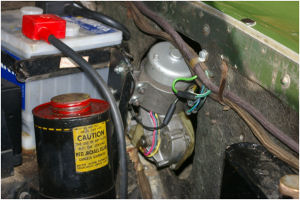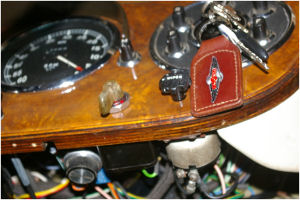The windscreen wipers on my 1956 Lagonda 3 litre have been troublesome since I bought the car back in 2006. I had only owned the car for a couple of weeks when I was caught out in a torrential downpour and the wipers were stuck below the screen rubber and my arm was not long enough to reach out of the window. I managed to pull into a lay-by and wait for the rain to ease off. I lifted the wipers up and switched on, and much to my relief they worked okay. If they do not go below the screen rubber all is satisfactory. Altering the position is not much better because then they hit the windscreen rubber on the other end of the sweep damaging the blades and screen rubber or sometimes knocking the blades off the arms. At times, you only need the wipers occasionally so there is constant switching on and off only to find that they pop below the screen when you need them urgently. Ideally, a dwell unit or intermittent wipe relay is needed. With the Lucas DR3 as fitted to the Lagonda they do not adapt readily to dwell unit. I had Jaguars in the 60’s and 70’s with the same motor although I did overcome the problems with the shuffle on parking which happens when the polarity is reversed for parking enabling the blades to park off screen. This is not good if you want a dwell unit. The Jaguars never suffered with starting with the blades below the the screen unlike the Lagonda.
One modification is to fit the later permanent magnet motor wiper units; a lot of 1960’s Jaguars fit these units as a dwell relay can be fitted to give the intermittent wipe. I thought that I would be able to fit a Lucas 16W unit straight from a Jaguar XJ6 Series 3. I have used these on old Jaguars before and I just happened to have a couple of Lucas 16W motors in my garage. Unfortunately, one did not work on slow speed and the other worked okay but the rack cable is too short.
I wanted to sort out the electrical side before I started any modifications to the car itself and the switching was beginning to cause me a lot of head-scratching. I would need a spare switch as I did not want to use the one fitted to the dashboard until I had proved the system. I trawled the internet for a Lucas PRS5 switch (a PRS7 can be used as it as it has the same knob fixing but it has 13 terminals in place of the 8 on the PRS5). I could not find any PRS5 switches but did locate a later PRS7. There are several types that I did not know. I thought of Harry Taylor who has helped me in the past and he came up trumps. Thank you Harry!
I made up a test rig on the bench using the working Lucas 16W unit. It took a couple of days with many sketches of the wiring only to find that I could only overcome the park control with a relay using the PRS5 switch. I achieved a very satisfactory operation on the bench. Then I removed the wiper motor from the Lagonda to see what the sweep would be. The gear drives are marked with the degree of sweep. The DR3 unit has 125 on it and the 16W 120 and so I thought that this would be a good start. However, the throw of the DR3 was about 30mm and the 16W was 44mm which gave a sweep of 180 degrees as the wheel boxes are different and need changing of the use of an alternative gear assembly. Spares for 16W units are no longer available but the other option is to buy a kit. There are a few kit car parts suppliers who do a Lucas14W wiper kit with various operating sweeps and a sweep angle of 130 is available. Wheel boxes need changing if one of these kits are used.
Before investing in a new kit I decided to have a go with what I had. The drive pin on the 16W could be moved to give the same throw as the DR3 motor. This involved removing the drive plate from the gear by drilling out rivets. Then the pin was removed and welded to a new position. A further bench test gave the same throw as the original. Then it was tested in the car and the motor fitted in a perfect position. I made up a different fixing clamp to that of the 16W as on a Jaguar as I did not want to alter the bracket on the bulkhead of the car. The 16W clamp is a saddle type. I made a circular one with a 3mm rubber strip to help with vibration and fitted to an adapter plate and then to the original mounting bracket.
Dwell relays are available for many cars. Some are programmable for the time delay but cheaper ones are fixed. The number of terminals varies. There are dozens on Ebay. I purchased a dwell kit from Maplins Electronics for £8.00 which has to be built up. This unit did not like my car’s electrical system. It was okay until the engine was started and then its relay would buzz. I fitted an electrical filter to the supply and this seemed to cure the problem. I know that a yellow Jaguar XJ6 relay will work and I have bought these at auto jumbles in the past for a couple of pounds. There’s almost certainly one in my many boxes of parts but I have yet to find it.
I am pleased to say that the modification works very well and will see how it goes. If all is satisfactory I will wait before I spend £200.00 on new equipment.
Robin Allum


